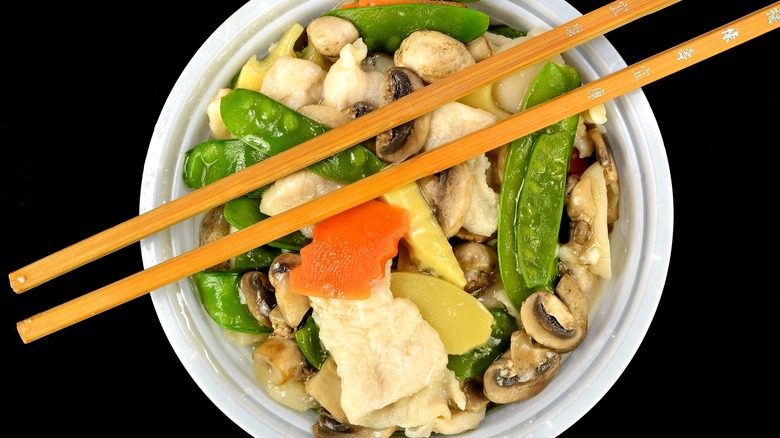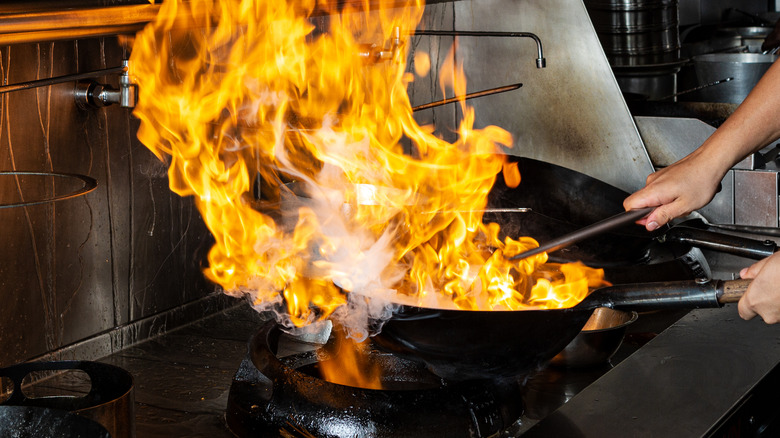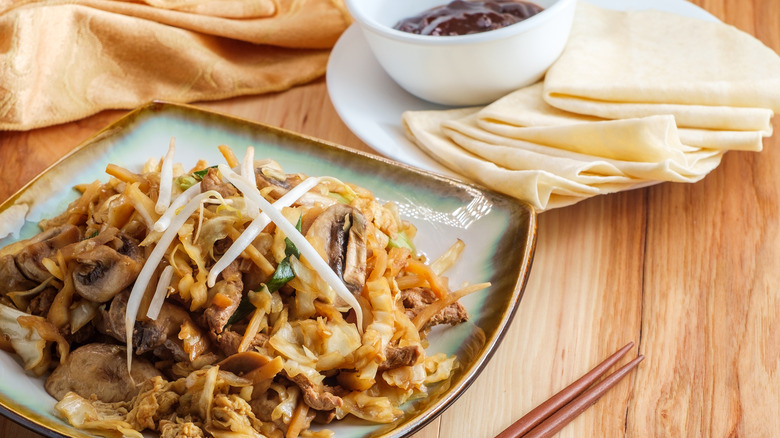The Classic Ingredients That Make Up Moo Goo Gai Pan
You're at your favorite local Chinese-American restaurant, savoring a delicious plate of velvety moo goo gai pan. Every bite is a harmonious blend of chicken, button mushrooms, crisp bamboo shoots and snow peas, and an umami-packed sauce that usually includes oyster sauce. But have you ever wondered about the story behind this famous dish and its classic ingredients?
This tantalizing plate of moo goo gai pan, or "mushroom chicken slice" in Cantonese and Taishanese, made a long journey from the Guangdong province in southern China to America in the 1800s. Brought by industrious Chinese immigrants, it was initially meant as a nutritious and comforting sustenance for the hardworking Chinese laborers building the foundations of America.
A classic and timeless dish, moo goo gai pan has gradually evolved to fit the western palate while preserving the heart of its original flavors. Making moo goo gai pan at home is easier than you might think, thanks to its uncomplicated ingredients and the ease of stir-frying them all together.
Heat up your wok and easily stir fry moo goo gai pan at home
Creating moo goo gai pan at home begins with the dish's star: thin slices of boneless, skinless chicken breast marinated with cornstarch and salt, then lightly sautéed until browned. This is followed by garlic, fresh ginger, and scallions added to the pan. Vegetables such as sliced mushrooms, carrots, snow peas, bamboo shoots, and water chestnuts join next, creating a vibrant, crisp medley. Bathe the ingredients with a savory sauce made from soy sauce, oyster sauce, sesame oil, chicken broth, and a sprinkle of sugar. Finally, garnish with green scallions and, optionally, roasted sesame seeds, and serve immediately.
Typically, moo goo gai pan is paired with a bowl of fluffy white rice or noodles. For those who love heat, drizzle on spoonfuls of chili crisp oil. To complete the meal, consider a palate-cleansing dessert like almond jelly or a tong shui (sweet soup) like red bean soup, bubur cha cha, or taro sago with coconut milk.
The marked differences between moo goo gai pan and moo shu
Adaptable and versatile, moo goo gai pan allows for creativity in the kitchen. While chicken is traditionally the star, you can switch the protein to suit your preferences. Beef, pork, or shrimp can take center stage, though such a swap would technically turn the dish's name into a misnomer. The vegetable medley can also be customized to your taste or what is seasonally available. Classic ingredients like water chestnuts, bamboo shoots, and mushrooms might be complemented or substituted with bell peppers, baby corn, carrots, broccoli, or bok choy.
And for the vegans out there, replace the chicken with your favorite vegan protein — firm tofu is a popular choice, along with tempeh, seitan, or king oyster mushrooms. As for the sauce, use vegan oyster sauce and vegetable broth.
While enjoying your homemade moo goo gai pan, you might wonder about its similarities with other Chinese dishes like moo shu. Originating from northern China, moo shu typically includes pork (or another protein like chicken), a mix of vegetables, and scrambled eggs, and it is stir-fried in a sweeter, darker, and thicker sauce. Moo shu is often served with hoisin sauce and thin crepe-like pancakes (or Mandarin pancakes) on the side for wrapping. Both classic dishes, rooted in Chinese cuisine's diverse landscapes, are ripe with history and worth exploring and savoring.


